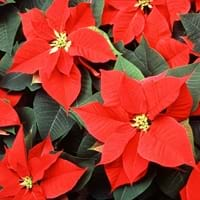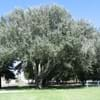Life Span
Perennial
Perennial
Type
Needled or Scaled Evergreen
Shrub
Origin
Western United States
Mexico
Types
Not Available
Prestige Red Poinsettiea, Snowcap White Poinsettia, Sparkling Punch Poinsettia, Enduring Pink Poinsttia
Number of Varieties
Not Available
Habitat
Rocky areas, Slopes
Forest edges, Tropical regions
USDA Hardiness Zone
2-9
9-15
AHS Heat Zone
Not Available
12-10
Sunset Zone
A2, A3, 1a, 1b, 2a, 2b, 3a, 3b, 4, 5, 6, 7, 8, 9, 10, 11, 14, 15, 16, 17, 18, 19
H1, H2, 13, 16, 17, 18, 19, 20, 21, 22, 23, 24
Habit
Pyramidal
Upright/Erect
Flower Color
Not Available
Yellow, Red, Light Pink, Coral
Flower Color Modifier
Bicolor
Multi-Color
Fruit Color
Chocolate
Not Available
Leaf Color in Spring
Green
Green, Dark Green
Leaf Color in Summer
Green
Dark Green
Leaf Color in Fall
Green
Dark Green
Leaf Color in Winter
Green
Green, Dark Green
Leaf Shape
Needle like
Bracts
Plant Season
Spring, Summer, Fall, Winter
Fall, Winter
Sunlight
Full Sun
Full Sun, Partial Sun
Growth Rate
Very Slow
Medium
Type of Soil
Loam, Sand
Loam, Sand
The pH of Soil
Neutral
Acidic, Neutral
Soil Drainage
Well drained
Well drained
Bloom Time
Not Available
Late Fall, Early Winter, Winter
Tolerances
Drought
Drought
Where to Plant?
Ground
Container, Ground, Pot
How to Plant?
Seedlings
Seedlings
Plant Maintenance
Medium
Medium
Watering Requirements
Average Water Needs
Keep the ground moist but not water-logged, Requires regular watering, Requires watering in the growing season
In Summer
Lots of watering
Lots of watering
In Spring
Moderate
Moderate
In Winter
Average Water
Average Water
Soil pH
Acidic, Neutral, Alkaline
Acidic, Neutral
Soil Type
Clay, Loam, Sand
Loam, Sand
Soil Drainage Capacity
Well drained
Well drained
Sun Exposure
Full Sun, Partial Sun
Full Sun, Partial Sun
Pruning
Cut limbs, Pinch Tips, Remove branches, Remove damaged leaves, Remove dead branches, Remove dead leaves, Remove dead or diseased plant parts
Do not prune during shooting season, Prune after flowering, Prune lower leaves, Prune to control growth, Requires little pruning
Fertilizers
All-Purpose Liquid Fertilizer
All-Purpose Liquid Fertilizer
Pests and Diseases
Red blotch
Bacterial Stem Rot, Botrytis Blight, Canker, Powdery mildew, Pythium rot, Rhizoctonia Root Rot
Plant Tolerance
Drought
Drought
Flower Petal Number
Not Available
Single
Foliage Texture
Fine
Coarse
Foliage Sheen
Matte
Matte
Attracts
Birds
Not Available
Allergy
Congestion, Dermatitis, Itchiness, Itchy eyes, Runny nose, Whooping Cough
Eye irritation, Mouth itching, Skin rash, Stomach burn, Throat itching
Aesthetic Uses
Bonsai, Borders
Beautification, Bouquets, Showy Purposes
Beauty Benefits
Not Available
Not Available
Environmental Uses
Air purification, Wildlife
Air purification
Medicinal Uses
Antiseptic, Bladder Infection, Boils, Burns, Cold, Cough, Diuretic, Kidney problems, Poultice, Respiratory Disorders, Rheumatism, Skin Disorders, tuberculosis, Vermifuge, Wounds
Fever, Pain killer, Tooth ache
Part of Plant Used
Leaves
Flowers, Leaves
Other Uses
Used as Christmas Tree, Used in herbal medicines
Economic Purpose, Showy Purposes, Used as Ornamental plant
Used As Indoor Plant
No
Yes
Used As Outdoor Plant
Yes
Yes
Garden Design
Feature Plant, Foundation, Mixed Border, Rock Garden / Wall, Topiary / Bonsai / Espalier
Container, Feature Plant, Houseplant, Mixed Border, Tropical
Botanical Name
PINUS aristata 'Sherwood Compact'
EUPHORBIA pulcherrima '490 Jingle Bells'
Common Name
Bristlecone Pine
Poinsettia
In Hindi
ब्रिस्टलकोन पाइन
पेड़
Poinsettia
In German
Bristlecone Pine
Baum
Poinsettia
In French
Bristlecone Pine
Arbre
Poinsettia
In Spanish
Pino de cerdas cónicas
Árbol
Poinsettia
In Greek
Bristlecone Pine
Δέντρο
Αλεξανδρινό
In Portuguese
Bristlecone Pine
Árvore
Poinsétia
In Polish
Sosna oścista
Drzewo
Poinsecja
In Latin
Pinus Bristlecone
ligno
Poinsettia
Phylum
Coniferophyta
Anthophyta
Class
Pinopsida
Eudicotyledones
Order
Pinales
Malpighiales
Family
Pinaceae
Euphorbiaceae
Clade
Not Available
Angiosperms, Eudicots, Rosids
Tribe
Not Available
Not Available
Subfamily
Not Available
Not Available
Number of Species
Not Available
Importance of Bristlecone Pine and Poinsettia
Want to have the most appropriate plant for your garden? You might want to know the importance of Bristlecone Pine and Poinsettia. Basically, these two plants vary in many aspects. Compare Bristlecone Pine and Poinsettia as they differ in many characteristics such as their life, care, benefits, facts, etc. Every gardener must at least have the slightest clue about the plants he wants to plant in his garden. Compare their benefits, which differ in many ways like facts and uses. The medicinal use of Bristlecone Pine is Antiseptic, Bladder Infection, Boils, Burns, Cold, Cough, Diuretic, Kidney problems, Poultice, Respiratory Disorders, Rheumatism, Skin Disorders, tuberculosis, Vermifuge and Wounds whereas of Poinsettia is Fever, Pain killer and Tooth ache. Bristlecone Pine has beauty benefits as follows: Not Available while Poinsettia has beauty benefits as follows: Not Available.
Compare Facts of Bristlecone Pine vs Poinsettia
How to choose the best garden plant for your garden depending upon its facts? Here garden plant comparison will help you to solve this query. Compare the facts of Bristlecone Pine vs Poinsettia and know which one to choose. As garden plants have benefits and other uses, allergy is also a major drawback of plants for some people. Allergic reactions of Bristlecone Pine are Congestion, Dermatitis, Itchiness, Itchy eyes, Runny nose and Whooping Cough whereas of Poinsettia have Eye irritation, Mouth itching, Skin rash, Stomach burn and Throat itching respectively. Having a fruit bearing plant in your garden can be a plus point of your garden. Bristlecone Pine has no showy fruits and Poinsettia has no showy fruits. Also Bristlecone Pine is not flowering and Poinsettia is flowering. You can compare Bristlecone Pine and Poinsettia facts and facts of other plants too.





